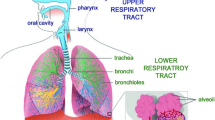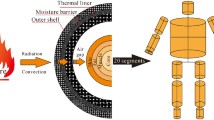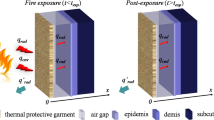Abstract
In this study, predicted dynamic physiological responses are compared with wear trials results for firefighter suits: impermeable (A), semi-permeable (B) and permeable (C), and underwear. Wear trials consisted of three rest phases and two moderate work phases, with a frontal infrared (IR) radiation exposure of 500 W/m2 for the last 15 min of each work phase. Simulations were performed by detailed modelling of the experimental boundary conditions, including the inhomogeneous IR radiation combined with clothing properties for still and walking conditions measured using the Sweating Agile thermal Manikin. Accounting for the effect of sweat gland activity suppression with increased skin wettedness, the predicted total moisture loss was insignificantly different (P<0.05) from the wear trial value for suits B and C but was 37% too high for suit A. Predicted evolution of core, mean skin and local skin temperatures agreed well with the wear trial results for all clothing. Root mean square deviations ranged from 0.11°C to 0.26°C for core temperatures and from 0.28°C to 0.38°C for mean skin temperatures, which where typically lower than the experimental error. Transient thermodynamic processes occurring within suit A may account for the delayed/reduced fall in core temperature following exercise.




Similar content being viewed by others
References
Fan J, Chen YS (2002) Measurement of clothing thermal insulation and moisture vapour resistance using a novel perspiring fabric thermal manikin. Meas Sci Technol 13:1115–1123
Fiala D, Lomas KJ, Stohrer M (1999) A computer model of human thermoregulation for a wide range of environmental conditions: the passive system. J Appl Physiol 87:1957–1972
Fiala D, Lomas KJ, Stohrer M (2001) Computer prediction of human thermoregulatory and temperature responses to a wide range of environmental conditions. Int J Biometeorol 45:143–159
Lotens WA (1993) Heat transfer from humans wearing clothing. Thesis, TNO Institute for Perception, Soesterberg, The Netherlands
McCullough EA, Jones BW, Tamura T (1989) A data base for determining the evaporative resistance of clothing. ASHRAE Trans 91:316–328
Nadel ER, Stolwijk JA (1973) Effect of skin wettedness on sweat gland response. J Appl Physiol 35: 689–694
Richards MGM (2000) Physiological studies of humans wearing fire fighter clothing systems for the validation of a sweating manikin. In: Werner J, Hexamer M (eds) ICEE 2000. Shaker, Aachen, pp 401–404
Richards MGM, Mattle NG (2001) A Sweating Agile thermal Manikin (SAM) developed to test complete clothing systems under normal and extreme conditions. In: Human factors and medicine panel symposium—blowing hot and cold: protecting against climatic extremes, vol4. RTO/NATO, Dresden, pp 1–7
Richards MGM, Mattle NG, Becker C (2003) Assessment of the protection and comfort of fire fighters’ clothing using a sweating manikin. In: Mäkinen H, Rossi R (eds) 2nd European Conference on Protective Clothing (ECPC) and NOKOBETEF 7, Montreaux, Switzerland
ThermoAnalytics (2001) Evaluation of the heat transfer mechanisms from RadTherm Technical Documentation, Calumet, Mich., pp 16–26
Tikuisis P (2000) Functional modeling in human thermoregulation to thermal stress. In: Werner J, Hexamer M (eds) Proceedings of the 9th international conference on environmental ergonomics, vol 7. Shaker, Dortmund, pp 375–380
Ward G, Shakespeare R (1990) Deterministic and Stochastic Ray Tracing. In: Rendering with radiance—the art and science of lighting visualisation. Morgan Kaufmann, San Francisco, pp 491–521
Author information
Authors and Affiliations
Corresponding author
Rights and permissions
About this article
Cite this article
Richards, M.G.M., Fiala, D. Modelling fire-fighter responses to exercise and asymmetric infrared radiation using a dynamic multi-mode model of human physiology and results from the Sweating Agile thermal Manikin. Eur J Appl Physiol 92, 649–653 (2004). https://doi.org/10.1007/s00421-004-1115-4
Accepted:
Published:
Issue Date:
DOI: https://doi.org/10.1007/s00421-004-1115-4




